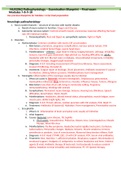Exam (elaborations)
NUR2063 Pathophysiology – Examination Blueprint – Final exam
- Course
- Institution
1. Neuro system features – structure of neurons with myelin sheaths a. Needs of neuro system to function: Oxygen and Glucose b. Autonomic nervous system: Controls smooth muscle, unconscious response affecting the heart rate, BP, intestinal motility i. Parasympathetic: Rest and Digest vs. symp...
[Show more]



